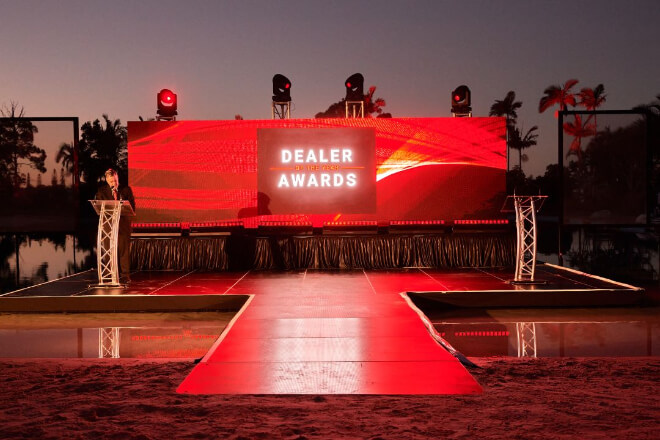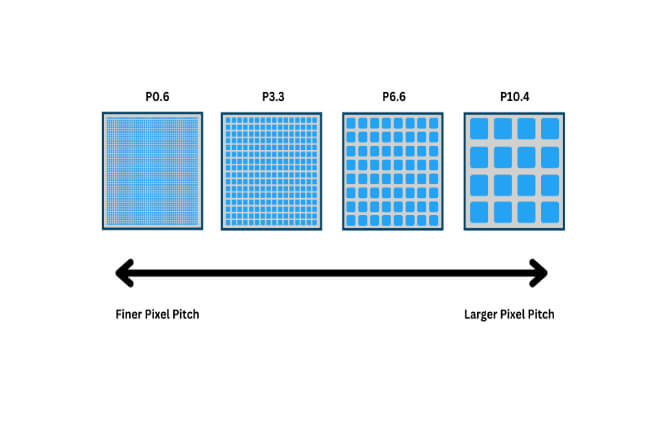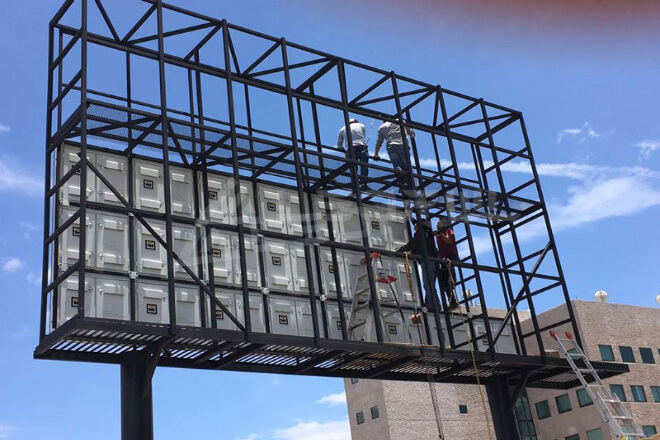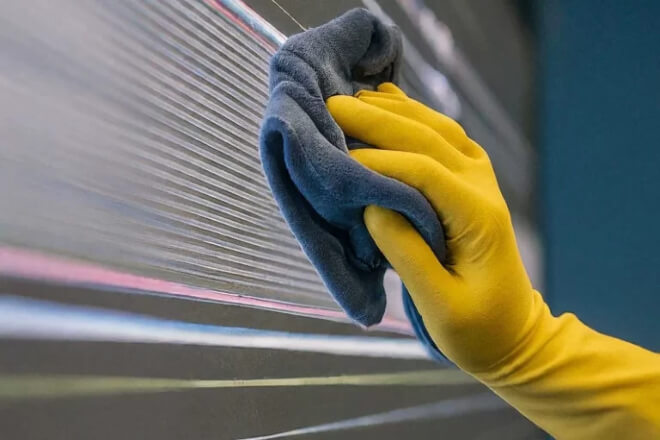Introducción

En la era digital actual, pantallas led are everywhere, from bustling commercial plazas to quiet conference rooms, from aeropuerto lounges to restaurant interiors.
They attract our attention with their colorful pictures. However, have you ever noticed that some LED screens always look blurry and make people feel uncomfortable? Why is this the case?
Tabla de contenido
Reason 1: Wrong dot pitch selection of LED screen

Some LED screens always look blurry and make people feel uncomfortable. In fact, this is probably because the dot pitch of the LED screen is not selected correctly.
Let’s talk about what dot pitch is first. Simply put, dot pitch is the distance between two small bright spots (that is, pixels) on the LED screen.
This distance is very important; it directly determines how much detail the screen can display. Imagine.
If the dot pitch is small, it’s like squeezing a lot of small bright spots together so that the screen can show more details and the picture looks clearer and more delicate.
For example, compared with a screen with a dot pitch of 2.5 mm, an LED screen with a dot pitch of only 1.2 mm can have many more small bright spots on the same size screen and can display richer image details.
However, if the dot pitch is too large, problems arise. When you look closely at the screen, it is easy to see individual small bright spots, and the whole picture is like being magnified by a magnifying glass, and it is all grainy.
It is like you are in an indoor conference room, very close to the screen. If you use an LED screen with a dot pitch that is too large, the images and text on it will definitely not be clear, and it will feel very blurry.
Moreover, the appropriate dot pitch is different for different places where LED screens are used. It depends on how far the audience is from the screen.
If the audience is far away, such as a large outdoor LED advertising screen, people stand dozens of meters away to watch, then it is quite appropriate to use an LED screen with a dot pitch of about 10-20 mm.
Because from such a long distance, the human eye can’t distinguish a single small bright spot at all, and the whole picture still looks very clear.
But if it is changed to an indoor exhibición hall, the audience is only a few meters away from the screen, and the screen with a large dot pitch is used, it will be terrible.
At a close distance, the gaps between the small bright spots can be seen clearly, the picture effect must be very poor, and the image looks blurry.
So, when choosing an LED screen, you must consider the dot pitch carefully. Otherwise, it will be a waste of money to buy a screen that is uncomfortable to look at.
Reason 2: The brightness and contrast of the LED screen

Let’s talk about brillo first. Brightness is like the “luminous intensity” of the screen. Imagine that if the screen brightness is too low, then in a place with strong ambient light.
For example, under the sun or in a bright indoor hall, the image on the screen will be “drowned” by the surrounding light, looking gray, and the details are not clear at all.
It’s like you are holding an old book and reading it in the sun, and the words on the book are almost invisible because the sun is too strong and “covers” the handwriting on the book.
In the same way, if the LED screen is not bright enough, the audience will feel that the screen is dim, and the outline and color of the image are blurred.
For example, in an outdoor commercial plaza, a merchant installed an LED screen for advertising.
If the brightness of this screen is not enough, when the sun is high, the advertising content on the screen will become blurred.
When pedestrians pass by, they can’t see the text and pattern details on the advertisement at all, and the advertising effect is greatly reduced. On the contrary, if the screen brightness is too high, there will be problems.
Especially in darker environments, such as movie theaters or indoor gatherings at night, overly bright screens will make people feel dazzled.
Moreover, too high of a brightness may also cause the color balance of the screen to be unbalanced.
It’s like if you put a very bright lamp in a dark room, the colors around the lamp will look a little distorted, either too bright or too dark; in short, it’s unnatural.
Similarly, if the brightness of the LED screen is too high, the color will become inaccurate, the bright areas will be too bright.
And the dark areas will not be dark enough, the whole picture will look inconsistent, and the clarity will also be affected.
Let’s talk about contrast. Contrast is like the “color layering” of the screen. Simply put, with high contrast, the white on the screen will be whiter, the black will be darker, the image will have richer layers, and the details will be clearer.
For example, if you look at a black-and-white photo, if the contrast is high and the black-and-white are distinct, the image will look very clear.
If the contrast is low, the transition between black and white is blurred, the image will appear very bland, and the details will not be clear.
If the contrast of the LED screen is not enough, the colors will appear very bland and without layers, whether in bright or dark areas.
It’s like you painted a colorful painting into a grayish color, and all the details and layers can’t be seen.
Especially when displaying some pictures with dark backgrounds or complex light and shadow effects, low-contrast screens will make the image look blurry, and it is difficult for viewers to distinguish the details in the image.
Reason 3: The installation position or angle of the LED display screen

Improper installation position will directly affect the audience’s viewing experience.
For example, in some Centros comerciales, LED screens are installed in the corners or at the edge of the hall, and viewers need to twist their necks or look at a very biased angle to see the screen.
In this case, the image on the screen will become distorted or blurred due to viewing angle problems.
For example, in a corner of a large shopping mall, an LED screen is installed to display promotional information.
Due to the relatively remote location, many customers can only see the screen from the side when passing by.
When viewed from the side, the text and images on the screen will be deformed, as if stretched or compressed, and the content cannot be seen clearly at all.
Moreover, if the screen is installed too high or too low, it will also make the audience feel uncomfortable.
For example, in some public places, the LED screen is installed too high, and the audience needs to look up to see it.
After a long time, they will feel neck pain, and naturally, they will not have the patience to carefully watch the content on the screen.
The installation angle is also critical. If the installation angle of the LED screen is not correct, the image on the screen may be reflected or glared when the audience watches it from the front, affecting the viewing effect.
This problem will be more obvious in an environment with natural light or strong light sources.
For example, in some conference rooms, the LED screen is installed slightly tilted, and the end close to the ceiling looks bright, while the end close to the ground is dark.
The whole picture looks very inconsistent, affecting the visual effect of the meeting.
The installation position and angle issues are often interrelated. If both of these are not handled well, the display effect of the LED screen will be greatly reduced.
For example, in a certain airport terminal, an LED screen for displaying flight information was installed.
Due to the remote location and the incorrect angle, passengers not only have to work hard to find the screen position when looking for their flight information.
They also have to look at it from a very awkward angle, and the text on the screen is not clear because of the reflection.
This not only brings inconvenience to passengers but also reduces the quality of airport services.
Therefore, the installation position and angle of the LED screen are very important factors. Before installation, you must fully consider the audience’s viewing habits and ambient light conditions.
Ensure that the screen can display the content in the best state so that the audience can watch clearly and comfortably.
Reason 4: The reason why the LED display screen has not been cleaned for a long time

During the use of the LED display screen, it will inevitably be stained with dust, stains, and other debris.
These dust and stains will adhere to the surface of the screen, affecting the normal emission and propagation of light, causing the screen to look blurry.
For example, at the entrance of the shopping mall, an LED screen was installed for advertising.
Due to the large flow of people in the mall and the high dust content in the air, the screen surface is quickly covered with dust.
From a distance, the image on the screen looks like it is covered with a layer of gray gauze; the color becomes dim, and the details are difficult to discern.
Moreover, dust not only affects the brightness and color of the screen but also may block the heat dissipation holes of the screen, causing the screen to overheat and further affecting the display effect.
If the LED screen is not cleaned for a long time, it will not only affect the display effect but may also cause permanent damage to the screen.
If dust and stains adhere to the screen for a long time, they may corrode the protective layer on the surface of the screen, causing scratches or damage to the screen.
This will not only affect the appearance of the screen but may also shorten its service life.
5. Conclusión
Through the above analysis, we can see that the clarity of the LED screen is affected by many factors, including dot pitch selection, brightness and contrast, installation position and angle, and cleaning and maintenance.
Understanding these reasons will not only help us make more informed decisions when purchasing and installing LED screens but also extend the service life of the screen and enhance the viewing experience.
Finalmente, si desea obtener más información sobre las pantallas LED, Por favor póngase en contacto con nosotros.
